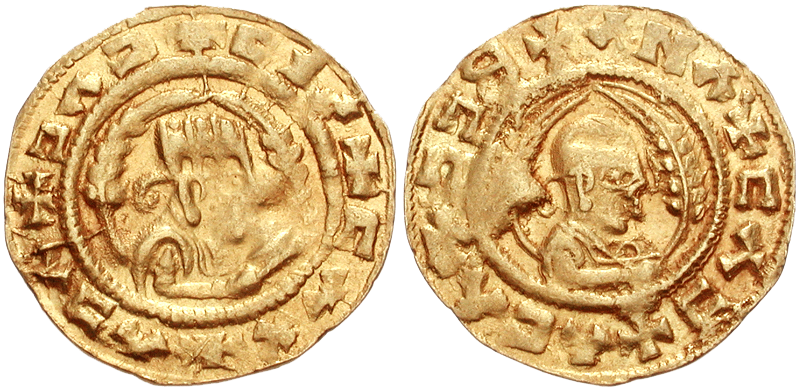One of the Four Greatest Powers in the World

5th Century Pyxis made of ivory and wood from the Aksumite Kingdom

Aksum was the name of a city and a kingdom which is essentially modern-day northern Ethiopia (Tigray province) and Eritrea. Research shows that Aksum was a major naval and trading power from the 1st to the 7th centuries C.E.

Another example of Axum’s tendency to profitably mix ideas from different cultures can be seen in the kingdom’s coinage, the first sub-Saharan kingdom to have its own mint. The gold and silver coins of Axum, which appeared from the 3rd century CE onwards, have Greek inscriptions, Sabaean religious symbols, and they were minted adhering to Roman standard weights.
ADDITIONAL INFORMATION
- The Kingdom of Aksum was an ancient kingdom centered in what is now Eritrea and the Tigray Region of northern Ethiopia
- Axumite Emperors were powerful sovereigns, styling themselves King of Kings
- Existed from about 80BC to AD825
- Aksum is mentioned in the first-century AD Periplus of the Erythraean Sea as an important market place for the trade in ivory which was exported throughout the ancient world
- It states that the ruler of Aksum in the first century was Zoskales, who, besides ruling the the kingdom, likewise controlled land near the Red Sea: Adulis and lands throughout the highlands of present day Eritrea; he is also said to have been familiar with Greek literature
- Aksum was previously thought to have been founded by the Sabaeans, who spoke a language from the Semitic branch of the Afroasiatic language family
- Evidence suggests that Semitic-speaking Aksumites semiticized the Agaw people, who originally spoke other Afroasiatic languages from the family’s Cushitic branch, and had already established an independent civilization in the territory before the arrival of the Sabaeans
- Other scholars point to the existence of an older kingdom known as D’mt, which flourished in the area between the 10th and 5th centuries BC, prior to the proposed Sabaean migration in the 4th or 5th century BC
- The Kingdom of Aksum was a trading empire centered in Eritrea and northern Ethiopia
- It existed 100-940 AD, growing from the Iron Age and achieved prominence by the 1st century AD
- According to the Book of Aksum, Aksum’s first capital, Mazaber, was built by Itiyopis, son of Cush; the capital was later moved to Axum in northern Ethiopia
- The Empire of Aksum at its height at times extended most of present day Eritrea, Ethiopia, Somalia, Djibouti and Yemen and parts of Sudan
- The Aksumites had cemeteries with elaborate grave stones called steele or obelisks
- By the reign of King Endubis in the late 3rd century, it had begun minting its own currency and was named by Mani as one of the 4 great powers of his time along with the Sasanian Empire, Roman Empire, and “Three Kingdoms” China
- The Aksumites adopted Christianity as its state religion in 325 or 328 AD under King Ezana and was the first state ever to use the image of the cross on its coins
- Around 330, Ezana of Axum led his army into the Kingdom of Meroë, conquering and sacking the town itself; a large stone monument was left there, and the conquest is also related on Ezana Stone
- Around 520, King Kaleb sent an expedition to Yemen against the Jewish Himyarite King Dhu Nuwas, who was persecuting the Christian community there
- For nearly half a century south Arabia would become an Ethiopian protectorate under Abraha and his son Masruq
- Aksum remained a strong empire and trading power until the rise of Islam in the 7th century
- Aksum remained on good terms with its Islamic neighbors and provided shelter to Muhammad’s early followers around 615
- After a second golden age in the early 6th century the empire began to decline in the mid 6th century, eventually ceasing its production of coins in the early 7th century
- Around this same time, the Aksumite population was forced to go farther inland to the highlands for protection, abandoning Aksum as the capital
- After a short Dark Age, the Aksumite Empire was succeeded by the Agaw Zagwe dynasty in the 11th or 12th century
- Aksum was deeply involved in the trade network between India and the Mediterranean exporting ivory, tortoise shell, gold and emeralds, and importing silk and spices
- Aksum’s access to both the Red Sea and the Upper Nile enabled its strong navy to profit in trade between various African (Nubia), Arabian (Yemen), and Indian states
- Salt was abundant in Aksum and was traded quite frequently
- Before its conversion to Christianity, the Aksumites practiced a polytheistic religion related to the religion practiced in southern Arabia

Leave a comment